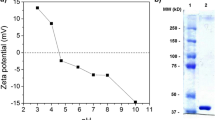Summary
Biotransformation of benzaldehyde to benzyl alcohol bySaccharomyces cerevisiae immobilized in different support matrices was investigated. Polymers with intrinsic hydrophobic and/or hydrophilic nature as well as mixed hydrophobic and hydrophilic supports were examined both in aqueous and bisphasic aqueous-organic systems. The hydrophobic support material ENTP-2000 or mixed silicone:alginate (50-25∶50-75) proved to be most suitable not only for nonconventional media but also for conventional aqueous media for production of benzyl alcohol. With ENTP-2000, catalytic activity and maximum yield were 159 μmol h−1 g−1 dry weight catalyst and 0.89 mM, respectively, in hexane containing 2% moisture. Corresponding values in aqueous media were 246 μmol h−1 g−1 dry weight catalyst and 1.53 mM. With 50∶50 silicone:alginate, catalytic activity and maximum yield were 177 μmol h−1 g−1 dry weight catalyst and 1.18 mM, respectively, in hexane containing 2% moisture. Corresponding values in aqueous media were 192 μmol h−1 g−1 dry weight catalyst and 0.8 mM.
Similar content being viewed by others
References
Fukui, S., K. Sonomoto and A. Tanaka. 1987. Entrapment of biocatalysts with photo-crosslinkable resin prepolymers and urethane resin prepolymers. In: Methods in Enzymology, vol. 135 (Mosbach, K., ed.), pp. 230–252, Academic Press, Florida.
Gorman, L.-A.S. and J.S. Dordick. 1992. Organic solvents strip water off enzymes. Biotechnol. Bioeng. 39: 392–397.
Kawakami, K. 1990. Characterization of production of 1,2-epoxyoctane from 1-octene by nongrowing cells ofNocardia corallina B-276 in aqueous-organic media. Ann. New York Acad. Sci. 613: 707–711.
Kawakami, K., S. Tsuruda and K. Miyagi. 1990. Immobilization of microbial cells in a mixed matrix of silicone polymer and calcium alginate gel: epoxidation of 1-ocetene byNocardia corallina B-276 in organic media. Biotechnol. Prog. 6: 357–361.
Kawakami, K., T. Abe and T. Yoshida. 1992. Siliconeimmobilized biocatalysts effective for bioconversions in nonaqueous media. Enzyme Microb. Technol. 14: 371–375.
Kierstan, M.P.J. and M.P. Coughlan. 1985. Immobilization of cells and enzymes by gel entrapment. In: Immobilized Cells and Enzymes: A Practical Approach (Woodward, J., ed.), pp. 39–48, IRL Press, Washington DC.
Nikolova, P. and O.P. Ward. 1992. Reductive biotransformation by wild type and mutant strains ofSaccharomyces cerevisiae in aqueous-organic solvent biphasic systems. Biotechnol. Bioeng. 39: 870–876.
Nikolova, P. and O.P. Ward. 1993. Effect of organic solvent on biotransformation of benzaldehyde to benzyl alcohol by free and silicone-alginate entrapped cells. Biotech. Tech. 7: 897–902.
Omata, T., A. Tanaka, T. Yamane and S. Fukui. 1979. Immobilization of microbial cells and enzymes with hydrophobic photo-crosslinkable resin polymers. European J. Appl. Microbiol. Biotechnol. 6: 207–215.
Oriel, P. 1988 Immobilization of recombinantEscherichia coli in silicone polymer beads. Enzyme Microb. Technol. 10: 518–523.
Park, T.G. and A.S. Hoffman. 1991. Immobilization ofArthrobacter simplex in thermally reversible hydrogels: effect of gel hydrophobicity on steroid conversion. biotechnol. Prog. 7: 383–390.
Sonomoto, K., A. Tanaka, T. Omata, T. Yamane and S. Fukui. 1979. Application of photo-crosslinkable resin prepolymers to entrap microbial cells, effects of increased cell-entrapping cell hydrophobicity on the hydrocortisone Δ1-dehydrogenation. European J. Appl. Microbiol. Biotechnol. 6: 325–334.
Tanaka, A. and T. Kawamoto. 1991. Immobilized enzymes in organic solvents. In: Protein Immobilization: Fundamentals and Applications (Taylor, R.F., ed.), pp. 183–209, Marcel Dekker, NY.
Tawaki, S. and A.M. Klibanov. 1992. Inversion of enzyme enantioselectivity mediated by the solvent. J. Am. Chem. Soc. 114: 1882–1884.
Yokozeki, K., S. Yamanaka, K. Takinami, Y. Hirose, A. Tanaka, K. Sonomoto and S. Fukui. 1982. Application of immobilized lipase to regio-specific interesterification of triglyceride in organic solvent. European J. Appl. Microbiol. Biotechnol. 14: 1–5.
Author information
Authors and Affiliations
Rights and permissions
About this article
Cite this article
Nikolova, P., Ward, O.P. Effect of the support matrix on biotransformation of benzaldehyde to benzyl alcohol by yeast cells in aqueous and aqueous-organic two phase systems. Journal of Industrial Microbiology 13, 172–176 (1994). https://doi.org/10.1007/BF01584003
Received:
Accepted:
Issue Date:
DOI: https://doi.org/10.1007/BF01584003




